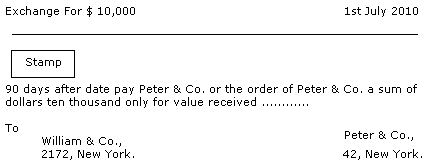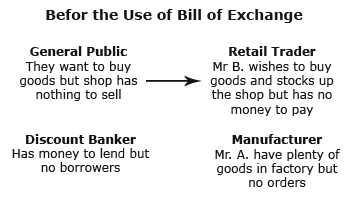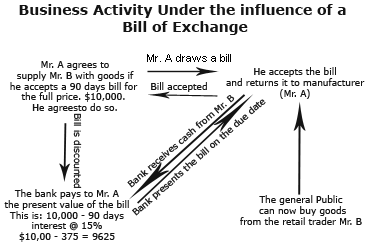|
No
business wants to sell goods on credit to his
customers who may prove unable or unwilling to pay
their debts. Today, however, in every field of
retail trade it appears that sales and profits can
be increased by selling goods on credit basis. The
manufacturers and the wholesalers sell goods mostly
on credit. Credit is a very powerful instrument to
promote sales, so most of the business transactions,
in most business concerns, are carried on credit
basis. A bill of exchange is a method
of payment used between businessmen which has
certain advantages over other methods of payment.
Contents:
"An
unconditional order in writing, addressed by one person
to another, signed by the person giving it, requiring
the person to whom it is addressed to pay on demand or
at a fixed or determinable future time a sum certain in
money to or to the order of a specified person, or
to the bearer".
You should
keep in mind the following points to understand the
definition:
-
The
person who writes out the order to pay is called the
drawer.
-
The person
upon whom the bill of exchange is drawn (who is ordered
to pay) is called the drawee.
-
The drawee may
"accept" the bill. This is a special use of the word accept
because it means that he accepts to pay the amount payable
expressed in the bill, i.e. if he accepts the obligation to
pay he writes "accepted" across the face of the bill and
signs it. From that time on he is know as the "acceptor" of
the bill and has absolute liability to honor the bill on the
due date.
-
The amount of
money must be mentioned clearly. For example, I cannot make
out a bill requiring someone to pay the value of my car or
house. That is an uncertain sum. It must say "five thousand
dollars or ten thousand dollars" etc.
-
The time must be
fixed or at least be determinable. For example, "sixty days
after date" is quite easily determinable. If the bill is made
out on first July, it will be 29th august.
-
The person who is
entitled to receive the money from the acceptor is called the
"payee". It is usually the drawer who is supplying goods to the
value of the bill, and wants to be paid for them. If the drawer
decides, the bill can be made payable to someone else by
endorsing it. That is why the definition says, to pay..... to, or
the the order of, a specified person.
-
A bill can be made
payable to a bearer, but it is risky, since any finder of the bill
or any thief, can claim the money from the acceptor.
Now read the definition
again and see the format of the bill of exchange below:

Important Points:
-
This bill is drawn by
the peter & Co., so the drawer of the bill is peter & Co.
-
The bill is drawn upon
William & Co., so they are drawee of the bill. They have not yet
accepted the bill, and so are not liable to pay it at maturity.
-
The bill is an
unconditional order in writing. It says "pay ten thousand dollars to
Peter & Co." it does not say "provided you are in funds". It just says
"pay!".
-
It is addressed by one person
(Peter & Co.) to another (William & Co.) and is signed by the person giving
it (Peter & Co.).
-
The date is easily determinable it is 90 days after first July, which is 29 September, 20....
-
The sum of money is very certain,
ten thousand US dollars.
-
The bill is payable to, or to the
order of, Peter & Co.
-
A person who wants to purchase
goods but has no money, may agree to accept a bill of exchange drawn upon
him at some future date for the value of the goods he wants to purchase. For
example, Mr. B (a retail trader) wishes to purchase furniture from a
furniture manufacturer (Mr. A) but has no money. Mr. A is agreed to sell
furniture for a 90 days credit worth $10,000.
-
The drawer (Mr. A) draws a bill
for $10,000 on the customer (Mr. B), the drawee, who accepts it (thus becoming
the acceptor of the bill) and returns it to the drawer. The drawer delivers the
furniture and has a 90 days bill for $10,000.
-
He can keep the bill till due date
and present it on the due date before the acceptor.
-
When a drawee (the acceptor)
acknowledges the obligation in the bill he is bound by law to honor the bill on
the due date. If he is a reputable person the bill is as good as money, and any
bank will discount it. There are special kinds of banks which do this job and
they are called discount houses. What do the discount houses do? They cash the
bill by giving the drawer the present value of the bill.
Present Value = Face value of the bill -
Interest at agreed rate for the time the bank has to wait
So the drawer
who discounts the bill with the bank gets less than the face value.
- On the due date the bank will present the bill
to the acceptor, who honors it by paying the full value. The bank has earned
the amount of interest it deducted when it discounted the bill.
Where does the acceptor get the money to honor
the bill? The answer is that he was given 90 days to sell the goods at profit,
and therefore, he is liable to honor the bill. Now it is hoped that you will be
able to follow what is happening in the following diagrams:

You can understand the figure above with the
help of the following notes:
- Business activities cannot proceed because
the retail trader (Mr. B) has nothing to sell and has no money to buy goods.
- We need a system by which retailer can
purchase goods without paying for them at the moment and which enables the
manufacturer (Mr. A) to be paid immediately.
- Since a bill of exchange from a reputable
trader is almost as good as money, it will be acceptable to banks. They have
plenty of money to lend out to reliable customers so, they will advance
money to the holder of bills of exchange.
Now look at the following figure and note how bill
of exchange can increase the business activities.

The result is that a bill of
exchange is a useful instrument to increase business activities, and is
beneficial to all the parties. |